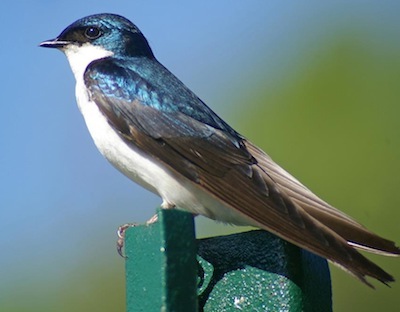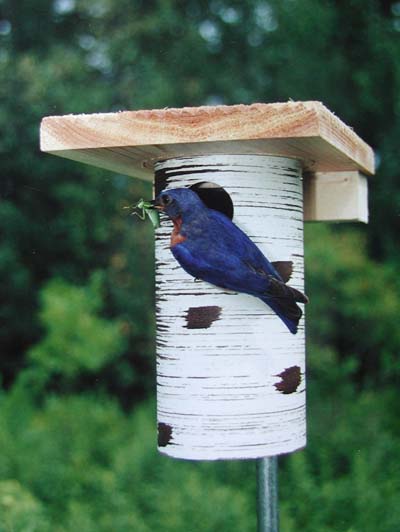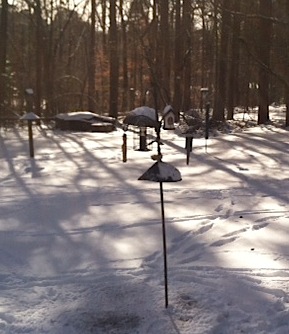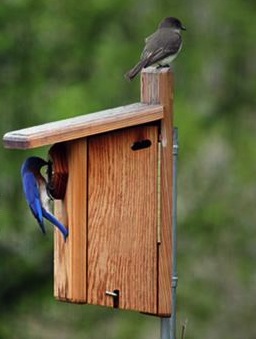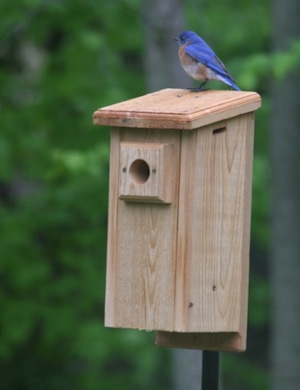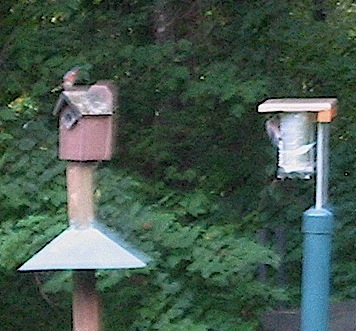-
Tree Swallows Like Blue Bird Houses too
Their migration is underway! Lucky little fliers spend their winters in the Caribbean, Central America, and the Southern-most parts of Texas and California. They’re heading as far north as Alaska and Canada, seeking mates and natural nest cavities or birdhouses to raise their young. Competition for nest sites is brutal… real estate’s tough out there!
Dwindling and disappearing habitat being a major cause, with fewer snags (dead trees) left intact. Non-native birds are also seeking the same nest spots and put up one fierce fight for the right to claim territory. European starlings and house sparrows wreak havoc on tree swallows, purple martins and bluebirds alike. Just ask any landlord, most will have sad tale or two to tell. Many people who offer martin houses or blue bird houses will discourage these aggressive species in order to protect native songbirds.
A favorite house among our “blues” here in the southeast is the Gilbertson Nest Box, and tree swallows will commonly use them as well.
A sturdy vinyl nest box with wood roof, it’s easy to monitor and reasonably priced. You can get one for the bluebirds and one for tree swallows! Just don’t place them too close together. For best results, one in the front and one in the back is a pretty good rule of thumb.
Because all blue bird houses are not created equal, we highly encourage anyone serious about helping bluebirds to use houses approved by The North American Bluebird Society. When you see the acronym NABS… you’ll know!
Celebrate spring and help welcome all migratory friends from their long journeys North!
Nab 10% off site-wide on all bird houses, seed feeders, birdbaths and hummingbird feeders too. And don’t forget the nesting material… we’re giving that away free with all orders through May 15th!
Use promo code MC10
Now Come on spring 🙂 -
They’re Scouting Bluebird Houses Already!
Despite adverse conditions of the polar vortex and another extreme winter, bluebirds and others are on the move, searching for suitable digs to raise their young. Even though snow is covering most of the country, Mother Nature’s biological clock tells them it’s time, the calendar and number of daylight hours is what lets them know.
Early migrating birds on the Atlantic Flyway like swallows, warblers and flycatchers rely on insects as they island hop through the Caribbean onto Cuba. When making landfall along the gulf states, their usual smorgasbord of insects, flowers, fruits and berries will be be scarce. Many neo-tropicals, including hummingbirds run the risk of depleting fat reserves before they reach spring breeding grounds here in the US. Simply put, if you think the weather has been an inconvenience – it makes life miserable for wildlife as well, and many birds just won’t make it 🙁
Closer to home, over-wintering residents like bluebirds are already checking bluebird houses to claim for nesting and raising their broods. With snow on the ground and high temperatures right at freezing, you can hear birds belting out their breeding songs! If there was a way to say “wait… it’s still too cold!” we most certainly would-but then again, man is no force against nature.
Best we can do is help feathered friends along the way by offering fresh water, food, and birdhouses that are ready for nesting. If you haven’t done so already, please check your bluebird houses and remove old nests. Be sure they are secure, sturdy and ready for vacancy. If you can stomach it, live mealworms are their favorite, but suet, peanuts and sunflower hearts also offer much needed fat and proteins.
An Eastern Phoebe perches atop this bluebird house while the male checks out its interior. Phoebes won’t use these houses, but may take up residence in barn swallow nest cups if you offer them in sheltered areas around your home.
During this treacherous weather… please help birds and wildlife with supplemental feeding and a heated water source… thanks on behalf of the birds 🙂
-
some blue bird houses are seeing 3rd or 4th nesting!
It’s been a strange season for birds in general due to the lengthy winter weather. Because some parts of the country were still seeing snow in late April and early May, mortality rates among nestlings were higher than usual. Colder than normal temps along with scarcity of natural food sources may have also accounted for some unsuccessful migrations of favorite feathered friends like hummingbirds. Many folks have reported seeing fewer of these sprites around feeders early in the season this year.
On the flip side, resident birds whose nesting season is about over, are attempting later than usual broods. Many blue bird houses which have already fledged two or three sets of nestlings are seeing their third and even fourth clutch of the season! This is all wonderful news for bluebirds… except for the searing temperatures July and August can bring.
If it’s hot outside, guaranteed it’s hotter inside a birdhouse. Babies can not regulate their body temperatures until they reach a certain age, but there are a few things you can do to help bluebirds (and others) beat the heat. First and foremost is to keep blue bird houses out of the sun, especially that baking afternoon sun. Moving a box a few feet where it’s shaded in the afternoon makes a difference in the ambient temperature inside the box. To featherless nestlings, just a few degrees can mean the difference between life or death. Birdbaths and Leaf Misters also help birds cool down during extreme heat. Parents will even shake themselves over babies dripping a bit of water to cool them.
Crazy as it sounds, there are other ways to cool down blue bird houses. Setting an ice pack or two on top of the house, attached with a large rubber band or bungee will help to cool temps inside. Recent discussions revealed a few folks putting up umbrellas to shade their nest boxes, again attached with bungee cords. Last summer we even wrapped our
Gilbertson nest box with a heat shield – the kind used for car windshields! Easy to measure, and simple to cut, duct tape and rubber bands held the soft shield securely in place. The blues didn’t mind it all, and it helped their digs and babies stay cooler. Four fledged in mid-August of 2012. Stats like these mean it’s not too late to offer bluebirds housing. At the very least, you may be providing a nightly winter roost for other resident birds.
The image isn’t so great, but you can see the foil-like cover on the round blue bird house to the right. It literally took five minutes to complete this easy project, and may have helped save four babies from succumbing to horrid heat.

